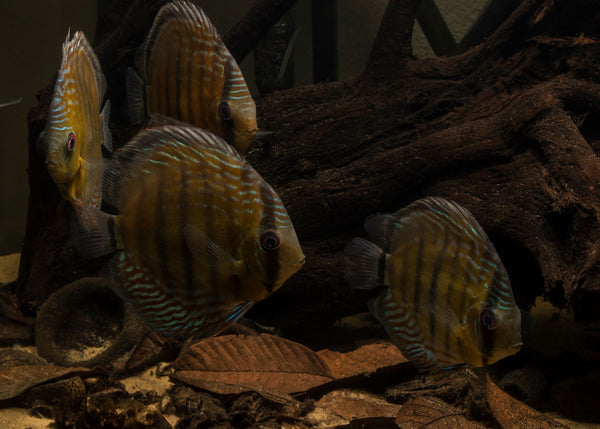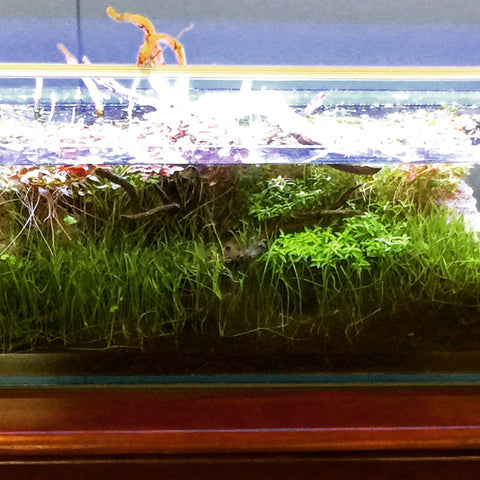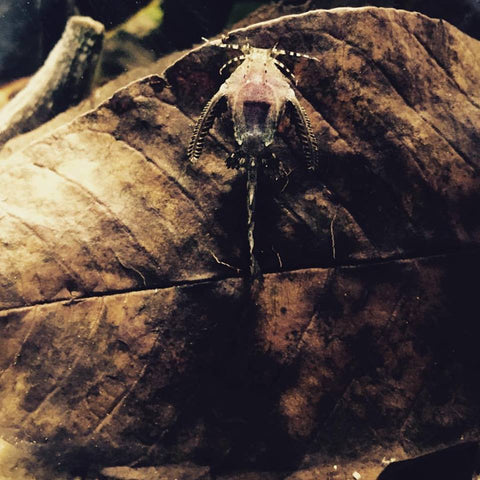- Continue Shopping
- Your Cart is Empty
Look out below! The alluring world of "alternative substrate materials!"
When it comes to freshwater aquariums in general, and botanical-style aquariums, specifically, the substrate has always been sort of an "afterthought." A component of the overall aquarium that has been largely viewed as, well- a component and little more. Something that you pour on the bottom of the tank, smooth it out, and move on to more "exciting" stuff...
And that's kind of a shame, right?
I mean, the substrate is more than just something to cover the bottom of the aquarium with. Rather, it's an important part of the overall miniature ecosystem that we create in our tanks. In fact, it's sort of an ecosystem in and of itself- a fascinating and compelling part of our aquariums!
If you're a regular consumer of our content, you know of my obsession with varying substrate compositions and what I call "enhancement" of the substrate- you know, adding mixes of various materials to create different aesthetics and function.

I'm fascinated with this stuff partly because substrates and the materials which comprise them are so intimately tied to the overall ecology of the aquatic environments in which they are found. Terrestrial materials, like soils, leaves, and bits of decomposing botanical materials become an important component of the substrate, and add to the biological function and diversity.

Now, there is a whole science around aquatic substrates and their morphology, formation, and accumulation- I don't pretend to know an iota about it other than skimming Marine biology/hydrology books and papers from time to time. However, merely exploring the information available on the tropical aquatic habitats we love so much- even just looking long and hard at some good underwater pics of them- can give us some good ideas!

How do these materials find their way into aquatic ecosystems?
In some areas- particularly streams which run through rain forests and such, the substrates are often simply a soil of some sort. A finer, darker-colored sediment or soil is not uncommon. These materials can profoundly influence water chemistry, based on the ionic, mineral, and physical concentrations of materials that are dissolved into the water. And it varies based on water velocities and such.
Meandering lowland rivers maintain their sediment loads by continually re-suspending and depositing materials within their channels- a key point when we consider how these materials arrive-and stay- in the aquatic ecosystems.

Okay, I could go on and on with my amateur, highly un-scientific review of substrates in Amazonia and elsewhere, but you get the point: There is more to the substrate materials found in Nature than just "sand." That's the biggest takeaway here. So, as hobbyists, we have more options and inspiration to to draw on to create more compelling substrates in our aquariums!
We talk about the concept of "substrate enhancement" or "enrichment" a lot in the context of botanicals (we tend to use the two terms interchangeably) around here. Now, we're not talking about "enrichment" in the same context as say, planted aquarium people, with materials put into the substrate specifically for the benefit of plants.
Rather, "enrichment" in our context refers to the addition of botanical materials for creating a more natural-appearing, natural-functioning substrate- one which provides a haven for microbial life, as well as for small crustaceans, biofilms, and even algae, to serve as a foraging area for our fishes and invertebrates. There is something oddly compelling to me when I look at both aquariums and natural biotopes with a diverse, interesting bottom structure.
There are a lot of interesting materials which you can experiment with in your substrate. Let's look at a few.

Leaves and botanical materials: You can utilize a bed of leaves on the bottom of your aquarium to not only form a substrate which will impart tannins and humic substances into the water- it will provide "fuel" for an entire population of microorganisms which drive the biological processes in our aquariums. As they decompose, leaves serve as food for this microcosm.
We've talked so much about leaf litter in the wild and in the aquarium over the years that it almost barely warrants discussion here; suffice it to say that utilizing leaf litter in our tanks is a fundamental part of the botanical-style aquarium approach.
Interesting semi-anecdotal observations from my friends in the know suggest that the biofilms for decaying leaves form a valuable secondary food for the fry of fishes such as Discus, Uaru, (after they’re done feeding on their parent’s exuded slime coat) and even Loricariid catfishes. And of course, all sorts of other grazing fishes, like some characins and even Cyprinids, can derive some nutrition from the fungi, bacteria, and small crustaceans which live in, on, and among the leaf litter bed.
I’ve seen fishes such as Pencilfish (specifically, but not limited to N. marginatus ) spend large amounts of time during the day picking at leaf litter and the surfaces of decomposing botanicals, and maintaining girth during periods when I’ve been traveling or what not, which leads me to believe they are deriving at least part of their nutrition from the leaf litter/botanical bed in the aquarium.

As I've obsessively reported to you, I set up a small tank in my office awhile back for the sole purpose of doing damn near the entire substrate with leaves and twigs- sort of like in Nature. There was less than approximately 0.25"/0.635cm of sand in there. I went from throwing in wood to make it look "cool", to ultimately yanking out everything but the leaves and just a few small twigs on the bottom. That's the whole "scape." What we in the reef world call a "no scape."
Leaves and a shoal of Parachierdon simulans.
Nothing else.

And the interesting thing about that tank is that it was one of the most chemically stable, low-maintenance tanks I've ever worked with. It held a TDS of 12 and a pH of 6.2 pretty much from day one of it's operation. It cycled in about 5-6 days. Ammonia was barely detectible. Nitrite peaked at about 0.25mg/L in approximately 3 days.
Now, the point is not to drop a big old "humble brag" about some cool tank I started. The point is to show what I think is an interesting "thing" I've noticed about this type of"leaf litter only" tank. Stability and ease of function.
I was quite astounded how a new tank could go from dry to "broken in" in a week or so. And not just "broken in" (ie; "cycled")- like, stable. I don't usually do this, but I tested all basic parameters every day for the first 3 weeks of the tank's existence, just to kind of see what would happen.
The "power" of these botanical-derived substrates comes from the organisms which reside in- and even consume- them!
Twigs: Have you ever thought of creating a substrate for your aquarium consisting entirely of twigs? I think that twigs are truly amazing materials to use for substrates for a variety of reasons. First, a "structure" of twigs offers an interesting "physical" structure within the aquarium, which provides bottom-dwelling fishes with a place to hide, forage, and spawn.

Second, like any other botanical material, twigs will impart tannins and humic substances into the water columns they decompose. One might call them an "active" substrate material!
Finally, twigs, by virtue of their abundant surface area, will provide a colonization substrate for fungi, biofilms, and other microbial growth. This is a huge thing and shouldn't be overlooked. In fact, the interstitial spaces created when you sort of "stack" (okay...more like, "toss") the twigs into place are really useful for all sorts of fishes and shrimp to inhabit!

Let's circle back again to some familiar themes.
We talk about the concept of "substrate enhancement" or "enrichment" a lot in the context of aquatic botanicals (we tend to use the two terms interchangeably). Again, we're not talking about "enrichment" in the same context as say, planted aquarium guys, with materials put into the substrate specifically for the benefit of plants. However, the addition of botanical and other materials CAN create a sort of organic "mulch" which benefits many aquatic plants!

Rather, "enrichment" in our context refers to the addition of botanical materials for creating a more natural-appearing, natural-functioning substrate- one which provides a haven for microbial life, as well as for small crustaceans, biofilms, and even algae, to serve as a foraging area for our fishes and invertebrates.
We've found over the years of playing with botanical materials that substrates can be really dynamic places, and benefit from the addition of leaves and other materials. For many years, substrates in aquarium were really just sands and gravels. With the popularity of planted aquariums, new materials, like soils and mineral additives, entered into the fray. With the botanical-style aquarium starting to gain in popularity, now you're seeing larger materials added on and in the substrate...for different reasons of course.

We've been offering various materials to add into your substrate for almost 5 years now...Stuff like the coconut-based "Fundo Tropical" and the smaller "Substrate Fino", or Coco Palm Bracts- materials which, in both look and feel- are far different from what is typically utilized in aquarium work.

You might say that, to some extent, an "enriched" or "enhanced" substrate functions as sort of a "refugium", providing protection for many beneficial creatures to grow and multiply. Many offer services like nutrient processing and scavenging of uneaten food, making this not only an aesthetically pleasing area within your aquarium- but a highly functional one, as well!
Now, there is way more than I could touch on in this brief blog, but the idea of "alternative substrate materials" is something that we should be exploring a lot in our botanical-style aquariums. I hope to talk about this a lot more in coming installments of "The Tint", and I'm sure we'll be discussing ideas for alternative substrates elsewhere as well!
Stay creative. Stay curious. Stay excited. Stay diligent. Stay observant...
And Stay Wet.
Scott Fellman
Tannin Aquatics









Scott Fellman
Author